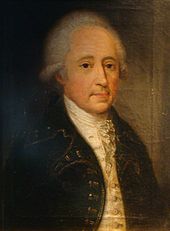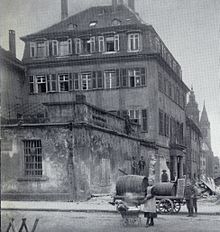Georg Heinrich von Roßkampff

Georg Heinrich von Roßkampff (* 9. December 1720 in Heilbronn , † 16th June 1794 ibid) was from 1751 Councilor and 1769-1794 Mayor during the last imperial city heyday in the history of the city of Heilbronn . He was a part-time building officer, the Heilbronn horse market and the construction of several splendid baroque buildings go back to him. In addition, Roßkampff was a Freemason and an active promoter of the poor .
Life
Georg Heinrich von Roßkampff was the youngest son of Josef Heinrich von Roßkampff (1681–1728) and his wife Anna Wilhelmina (1683–1766). The family originally came from Westphalia and came to Heilbronn with Georg Heinrich's grandfather Peter Roßkampff in 1677. This belonged to the "inner council" in Heilbronn and in 1690 was ennobled by the emperor. Georg Heinrich's father also became a senator in Heilbronn in 1716, but died when Georg Heinrich was 7 years old. The mother then entered into a second marriage with the vice-principal Johann Michael Wild. Georg Heinrich first attended the Heilbronn grammar school , where he also lived due to the position of the stepfather, and began studying law at the University of Jena at Easter 1740 , for which he received a four-year scholarship from the city of Heilbronn. After completing his studies, he was temporarily an external tutor before returning to Heilbronn in 1745 as a procurator (lawyer). In 1746 he became town clerk in Wimpfen . In 1749 he returned to Heilbronn as deputy town clerk, where he became town school attorney on January 2, 1750. On July 24th, 1751 he became senator of the small, inner council ( "von den burgern" ) of the imperial city Heilbronn, according to the custom he advanced to higher posts after the retirement of older council members. Already during his time as senator, in 1754 he conducted negotiations with Württemberg , which gave the imperial city of Heilbronn upper fiefdom over Neckargartach . In 1765 he was tax master . On March 21, 1769, after the death of Franz Leonhard Roth, he was elected third mayor and in 1781, after the resignation of Georg Philipp Mylius, he moved to the second position of mayor. In addition to Gottlob Moriz Christian von Wacks and Georg Christoph Kornacher , he remained the second mayor until his death in 1794. At that time Heilbronn had three mayors each, who took turns in the official business and whose rank as first, second or third mayor only affected the remuneration . Roßkampff was mayor for the first four months of the year.
Roßkampff was a builder from 1752 onwards. He had an orphanage, breeding and workhouse (later the Bläß'sche Palais ) built outside the city walls of Heilbronn in front of the Sülmertor . In 1761 he described the purpose of this institution as follows: “One seeks to improve people and not to spoil them”, which was characteristic of Roßkampff's social commitment. In 1760 he renewed the city's poor system. The Heilbronn Poor Ordinance, which he co-authored, forbade street begging, guaranteed orphans to be admitted to the orphanage and support for the poor through charitable foundations. The citizens of the city were obliged to make contributions to the poor. The social system developed by Roßkampff went beyond the needs as well as the means of the city of Heilbronn and was repeatedly the target of criticism, but was bitterly defended by Roßkampff during his lifetime. Shortly after his death, the orphanage was closed by the city council and sold to the Württemberg state in 1803.
In 1765 he planned the archive building on Kieselmarkt for the Heilbronn city archive . The representative building was appropriately furnished inside by the archivist Eberhard Ludwig Becht and served its original purpose until it was destroyed in the Second World War. The Heilbronn Hall of Honor was then set up in the ruins of the building . The Kraichgau archive of the knightly canton Kraichgau on the harbor market was also built under his direction. His house, the Roßkampffsche Haus in Heilbronn Presencegasse (later: Kaiserstraße ), was probably built according to his own plans .
Since 1768, Roßkampff also represented the interests of the city of Heilbronn in the planning of supraregional traffic routes in southern Germany. He obtained the connection of Heilbronn to the Chaussee coming from Cannstatt via Besigheim (today's B 27 ), which brought the transport of goods on the Neckar from Cannstatt to Heilbronn almost to a standstill by 1780. Since he had negotiated a road toll that was unfavorable for the imperial city - the road toll in one direction on Heilbronn territory went entirely to Württemberg - Roßkampff came under fire. He also campaigned for the connection of Heilbronn to a trade route leading to Nuremberg, the expansion of which, however, was rejected in 1782.
At his instigation, the Heilbronn cattle and horse market was founded in 1770 on the "Hammelwasen", which made Heilbronn an important agricultural center in the surrounding area and for which he had the shooting house built as a cattle market house. After 1790 he had a stately stone house built for himself on the Presencegasse (later at the corner of Kaiserstraße / Allee). He propagated the beautification of the cityscape and the representative building of houses from regional sandstone . The council resolution of 1778, which guaranteed builders of stone buildings free delivery of stones and sand, may go back to him.
Last but not least, the first cultivation of rapeseed and alfalfa near Heilbronn is said to go back to Roßkampff. Lucerne in particular spread rapidly from Heilbronn in the surrounding area.
The declared representative of the Enlightenment was initially from 1774 a member of the Meiningen Freemason Lodge Charlotte zu den Drei Nelken , from 1776 a member of the Stuttgart Lodge Karl zu den Drei Cedern and later a co-founder of the local lodge Zum Felsen der Truth . In the course of time Roßkampff developed - probably also through the appearance of several fraudsters posing as Freemasons - to an opponent of the teaching method of strict observance , which ended in 1782 after the Wilhelmsbader Konvent , at which Roßkampff was also present. After 1782 there are no more Masonic documents about Roßkampff. His correspondence in this regard, the so-called Roßkampff files, was stored in the Heilbronn lodge Karl zum Brunnen des Heil until Freemasonry was banned in 1935 .
His first marriage to Margaretha Metzger geb. Geiling (1710–1780), the daughter of the mayor Johann Georg Geiling , married. Through this marriage he was also the brother-in-law of Mayor Johannes Schübler . He was often a guest in the well-known "pancake house" run by those from Pancug, another well-known Heilbronn patrician family. In his second marriage in 1784 he married Rosina Elisabeth von Kinckel (1736-1808), the niece of Heilbronn mayor Georg Heinrich von Pancug and widow of Esslingen mayor Johann Andreas Harpprecht von Harpprechtstein (1706–1771). Neither the first marriage nor the second marriage resulted in children, nevertheless Roßkampff had an illegitimate daughter Johanna Christina Barbara, whose mother came from the Nübel butcher family. His fortune, a significant portion of which came from the inheritance of his wealthy first wife, amounted to 71,200 guilders in 1790 . This made Roßkampff the wealthiest non-merchant in town.
Roßkampff died of a stroke on June 16, 1794. In his will he had refused a Christian burial, so that at his funeral there was no prayer or singing. In 1799, a relief bust of the mayor designed by Josef Kayser was placed in the Roßkampff family grave.
The Roßkampffstraße in Heilbronn is named after Roßkampff .
literature
- Wilhelm Steinhilber : Mayor of Heilbronn in the 18th century (X) . In: Swabia and Franconia. Local history supplement of the Heilbronn voice . 12th year, no. 9 . Heilbronner Voice publishing house, September 10, 1966, ZDB -ID 128017-X .
- Hubert Weckbach : A man of special activity. Georg Heinrich von Roßkampff. In: Heilbronn heads III. Heilbronn City Archives, Heilbronn 2001, ISBN 3-928990-78-0 ( Small series of publications by the Heilbronn City Archives. Volume 48)
- Bernd Klagholz: Heilbronn and its mayors in the period from the 16th to the 19th century (approval work), Tübingen 1980, p. 90
- Christhard Schrenk , Hubert Weckbach: Preserving the past for the future. The Heilbronn City Archives: History - Tasks - Holdings (= publications of the Heilbronn City Archives. Volume 33). Stadtarchiv Heilbronn, Heilbronn 1993, ISBN 3-928990-41-1 , on Roßkampff especially pp. 42-46.
- Karl Hugo Popp and Hans Riexinger : On the history of the Heilbronn family Künckelin / von Kinckel . In: Historischer Verein Heilbronn, Jahrbuch 30, 1983, pp. 145–166, here pp. 163–166 (family tree of his second wife).
Individual evidence
- ↑ Moriz von Rauch: Heilbronn in the second half of the 18th century . In: From the Heilbronn city history. Selected essays on the history of the city of Heilbronn from volumes 1–16 of the yearbook of the Heilbronn Historical Society (yearbook for Swabian-Franconian history) . Jahrbuch Verlag, Weinsberg 1988. pp. 73-104
| personal data | |
|---|---|
| SURNAME | Roßkampff, Georg Heinrich von |
| BRIEF DESCRIPTION | Mayor of Heilbronn |
| DATE OF BIRTH | December 9, 1720 |
| PLACE OF BIRTH | Heilbronn |
| DATE OF DEATH | June 16, 1794 |
| Place of death | Heilbronn |



